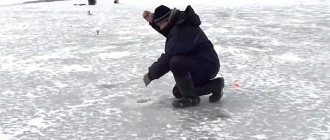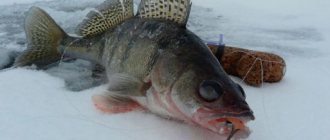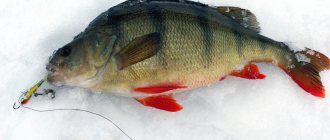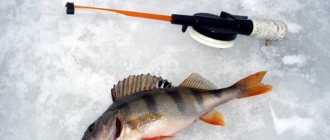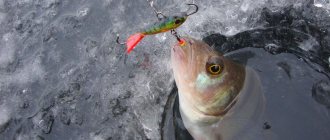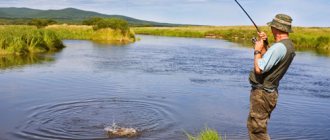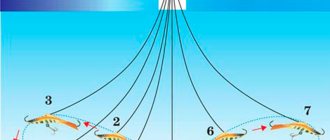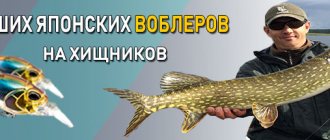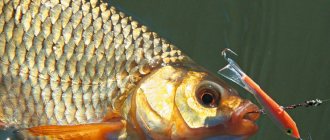How to fish correctly with a balance beam in winter:
The equipment when fishing with balance beams in winter also depends on the size and depth. So with any installation components:
- Correct selection of fishing rod flexibility.
- Choosing fishing line for winter fishing with balance beams.
- Correct tying of the bait and its position in the water.
- Equipping the rod with a nod (if necessary).
About what fishing line to use for winter fishing with balance beams.
Cloudflare Ray ID: 63a8bbfcbfd7cae4 • Your IP: 195.64.208.251 • Performance & security by Cloudflare
Of course, this equipment can also be used to catch pike, both small and large. Pike is quite omnivorous, it bites well on models of various colors, so it is very difficult to predict what pike will have as a priority today. We can safely say only one thing: pike mainly likes variants over 5 centimeters long. It doesn't respond as well to smaller models.
Size
This parameter in most cases is determined by what kind of fish you want to catch. If, for example, you plan to catch fish such as perch, then you should choose not very large specimens, since a large size can scare away the perch.
If the goal of fishing is a larger fish, then you can safely experiment with sizes. The biggest fish will not always bite the biggest bait, this is a big misconception. A large specimen can respond to a fairly small balancer.
Form
The choice of shapes in fishing stores is becoming larger and larger. In fact, there is no universal form that would suit all conditions at once. You will have to buy several different options, and then test them, only then will you be able to choose a favorite for yourself.
Only by trying new and new lures will you be able to build your arsenal of the best balancers with which you can achieve the desired results.
The variety of colors is also great. Brighter colors are great for murky water as they will stand out a bit, thereby attracting fish. Darker models can be used on reservoirs with rocky bottoms.
Dark baits will look most realistic in such conditions, which will not arouse any suspicion in the fish. It is best to purchase several different balancers at once, which will be painted in different colors. If suddenly a predator does not want to respond to one balancer, you can always replace it with another.
The price for such pleasure is quite reasonable. For an inexpensive Chinese version, which will be quite well assembled and also have a good game, you will have to pay approximately from 350 to 700 rubles . For a catchable bait, this is not so much.
If you want to purchase a more expensive option, which will be manufactured by some well-known brand, then you can safely prepare for its purchase from 800 to 3000 rubles. Such a balancer will be very good. It will also be assembled with very high quality, high-quality, expensive hooks will be built into it, which will not let you down.
Very interesting fishing takes place on the last ice. All my trophies were caught during this period, when the fish is preparing for spawning and gaining fat. Here you need to use all your dexterity and experience, because the fish at this time, although active, is capricious.
Winter is coming, and for fishermen this is usually good news. You can not only enjoy the beauty of winter nature, but also spend time actively fishing.
Author: Sergey Kurnosov, manager of the trade sector of Decathlon Ozernaya
What to take for winter fishing? I am ready to share with you my observations and the rich experience of my fellow fishermen. Let's start with the balancer - a very useful invention for lovers of winter fishing.
What is a balancer
A balancer is an artificial bait that resembles a small fish - they come in a variety of colors. There are hooks on the front and back of the balancer, and sometimes there is a tee with bright beads at the bottom. In the tail section it has two plastic plates that allow you to maintain a horizontal position when playing.
On the first ice, in the dead of winter and on the last ice, the balancer is selected by color and size. The size of the balancer is from 3 to 9 cm. Your choice will depend on the depth at which the fish lives.
About fishing on the first ice
I’m used to taking with me a lot of balancers of different colors, from 3 to 7 cm, on the first ice, because I know in advance that perch and pike are very active at this time, and cliffs, as well as moments when pike bites off the bait, are not excluded. Fishing is carried out in the coastal zone - from 50 cm from the bottom along the ice edge and up to 4-5 m along the edge.
For winter fishing in the coastal zone, I advise you to select a balancer from 3 to 5 cm, otherwise it will not “play” at such small depths. It can attract fish, there will even be bites, but if we make a mistake with the size, then the fish will just look at the balancer, nothing more.
First of all, this rule works when fishing for perch. I have observed it many times: the fish stands next to the balance beam and, no matter how much I change the style of play, does not attack. When changing the balancer to a brighter and smaller one, it began to peck, and very greedily and persistently. That's why you shouldn't be lazy - change the bait, it will bear fruit!
If the fish don't bite within 2-3 minutes of playing on the balancer, move to another hole - the fish are active at this time of year, and frequent visits to your old holes can help.
Playing style
Playing with the balance is carried out by raising the rod with quick upward jerks - usually at a distance of 5 to 15 cm. With this game, the balance reminds the predator of a small fish and provokes it to attack. Because of the plastic wings on the tail, the balancer remains horizontal, smoothly swaying in different directions during pauses between jerks.
Advice regarding sharp swings of the rod at a distance of more than 20-30 cm - it is better to avoid them! Otherwise, the balancer may turn over in the water and get caught by one of the hooks on the main fishing line - then it will no longer play, luring fish. You will immediately feel this change. If this happens, simply remove it from the water and remove the line from the hook.
Fishing with a balance beam in the middle of nowhere
Fishing is carried out in the same way as on the first ice, but there are a couple of nuances.
The first advantage of the wilderness is the strength of the ice. You can walk around the entire body of water without fear, knowing that you are not in danger of swimming in cold water. This will allow you to go to different interesting places - a snag, a quiet creek or an edge where a predator is most likely hiding.
The second advantage is that here every fisherman can test his arsenal and try out new lures and playing styles with them. At this time of year, predatory fish are more passive and come out to feed much less often than on the first and last ice. You need to be patient and select different baits and play on them very carefully.
I always take my entire arsenal of balance beams with me on the ice. First I fish the coastal zone with balancers from 3 to 5 cm, then I drill holes further and further from the shore in a checkerboard pattern in order to fish a larger area.
As soon as I find a fish, I begin to match the balance and style of play to the mood of the fish. At a depth of 4-8 meters I set it from 5 to 9 cm, because light baits are not so sensitive at great depths. At this time, the ice on the reservoir already reaches half a meter or more, drilling many holes is difficult, but it is necessary.
On a reservoir in the middle of nowhere, you have to look for fish, and I advise you not to stop for a long time on one hole, but to move on. The fish is more passive and stands in one place, unlike the first ice.
Fishing on the last ice
I want to warn you right away that going out on the ice alone on the first and last ice is very dangerous! Go with someone and take a rope with you so that if you or your comrades go under the ice, you have something to pull out.
Very interesting fishing takes place on the last ice. All my trophies were caught during this period, when the fish is preparing for spawning and gaining fat. Here you need to use all your dexterity and experience, because the fish at this time, although active, is capricious.
On the first and last ice, going out on the ice alone is very dangerous! Go with someone and take a rope with you
Fishing on the balance beam here is the same as on the first ice. We select the right size: in the coastal zone from 3-5 cm, away from the shore - 5-9 cm. And the color - to suit the mood of the fish.
And finally. It is important to understand that the choice of knives for drills, fishing rods and equipment plays a big role in fishing. For the first and last ice, I advise you to choose knives with a diameter of no more than 130 mm, and for deep winter conditions - no more than 170 mm. The rod should be light and durable so that your hand does not get tired and at the same time you can pull out a winter trophy without any problems. In terms of clothing, choose not very heavy equipment so as not to get tired, since catching a predator is very active. And of course, clothes should be warm.
A predator can stand at any height, especially for perch.
Balancer fishing technique
To successfully fish with this winter bait, you need to master the technique of retrieving it. The play of the balancer and how brightly it will open in the hands of the fisherman depend on correctly selected movements.
Basic balancer wiring looks like this::
The balancer sinks to the bottom. Then follows a leisurely rise of 20–30 cm. Afterwards, the angler swings the fishing rod. Its amplitude should not be large, 10–15 cm is enough. The movement is smoother than when fishing with vertical spoons. This is followed by a pause of up to 5–8 seconds, during which the accelerated bait describes a “figure eight” under the hole.
The smoothness of the swing and its amplitude depend on the model of the balancer. For some baits it is necessary to make sharper movements; some modifications prefer slow rises with acceleration at the top point. The optimal wiring is selected directly on the reservoir experimentally.
The shape of the bait affects the nature of the game of the balancer. Models whose center of mass is shifted to the head after deflection during the swing perform a sharp somersault and begin to move in the opposite direction. Such movements are good for exploratory fishing, when you first need to detect fish and determine the fishing horizon.
If a fish is found and the depth of its position is known, but it is not active enough and does not respond well to the aggressive movements of the bait, then you need to place a model with a narrow head. Such balancers make a smooth turn and move along a trajectory close to a circle.
The length of the pause after the swing plays an important role. If the bite is active and the fish greedily attacks the proposed object, then the stops should not be long. For passive underwater representatives, after stopping the movement of the balancer, it is preferable not to immediately make another rise. Often a predator does not dare to attack a moving bait, but pounces on a stopped one.
When fishing, you need to make it a rule to fish all the horizons right up to the ice. At a given depth, about 10–15 strokes are made, then the bait is raised 50 cm, and the next layer is examined.
A predator can stand at any height, especially for perch.
Catching perch on a balance beam in winter Perch is the most common trophy when fishing vertically on a balance beam in winter. Stripers can be very capricious - they can peck at one bait regularly, but ignore another. What is important when choosing bait?
Fishermen usually divide perch into 2 main subspecies:
Catching perch in winter on a balance beam - tactics, tackle and bait
Fishermen usually divide perch into 2 main subspecies:
- Small, “sports”, grassy. It develops very slowly and usually does not grow more than 70-100g. Forms large flocks. It feeds on small invertebrates, worms, and bloodworms.
- The deep, humpback, and okovalok are a real predator. Grows in our region for 1.5 kg. Forms not such extensive flocks. The main food is fish fry. This is what we will aim to catch on the balance beam!
Perch fishing is a very dynamic activity because... perch is a schooling and lively fish. If you manage to stumble upon a cluster of fish, then you can completely unwind! The fact is that this striped robber has a very strongly developed food competition reflex, in other words, his greed knows no bounds. He is ready to attack the bait just so that his brother from the pack does not get it. This is what experienced fishermen use.
Catching perch with balance beams is a fun and interesting way of fishing. It is believed that the best time for fishing with these baits is, first of all, the first ice, when the perch is most active. There is an opinion that during the dead winter period, when the striped fish does not have a good appetite, it is better to stir it up with smaller baits: jigs, little devils, “pussies”, etc. A separate detailed article has been written about catching perch with a jig.
According to the last ice, when the fish is preparing for spawning, full of caviar and milk, ichthyologists have the opinion that perch, during this period, has much less desire to attack large baits. But on the first ice you can get ahead of the daring, active perch 100%. But, this is just a theory!
On shallow lakes, the most working model is 4.5 cm, the most popular colors are “perch”, “roach”, “red head”. On the vast majority of purchased balancers of this size, the hanging tee is not reliable enough when catching large pike, so it is immediately replaced with a stronger one and one or two numbers larger, this does not spoil the game, and holds a decent predator much more reliably. For better efficiency, a small red cambric is placed on the forend of the tee.
Walking balancers
On shallow lakes, the most working model is 4.5 cm, the most popular colors are “perch”, “roach”, “red head”. On the vast majority of purchased balancers of this size, the hanging tee is not reliable enough when catching large pike, so it is immediately replaced with a stronger one and one or two numbers larger, this does not spoil the game, and holds a decent predator much more reliably. For better efficiency, a small red cambric is placed on the forend of the tee.
This does not mean at all that you cannot catch other predatory fish, such as pike, with perch bait. Pike also really like bleak and small perches, and therefore it is very possible to catch a pike with such a balancer.
Balancer selection
To choose this type of bait, many factors should be taken into account: standing water or current, small or large specimens, for pike or perch. Considering the fact that perch predominates in reservoirs (amateur fishermen mainly catch them), we can give several recommendations for choosing a balancer for perch fishing:
- To successfully catch medium and large sized perches, you can use balancers 3-4cm long.
- As a rule, the weight of such balancers ranges from 4-6g.
- The coloring should be bright and natural, reminiscent of perch or bleak.
- Particular attention should be paid to the quality of hooks. With bad (dull) hooks you can’t count on effective fishing.
This does not mean at all that you cannot catch other predatory fish, such as pike, with perch bait. Pike also really like bleak and small perches, and therefore it is very possible to catch a pike with such a balancer.
- In standing reservoirs with a maximum depth of up to 3 meters, lead fish up to 40 mm long and weighing no more than 5 g are used;
- On medium-flow rivers and standing reservoirs with depths of up to 5 meters, balancers 50-60 mm long and weighing up to 8 g are used;
- In strong currents they catch with heavy and large baits 75 mm long and weighing up to 20 g.
Fishing rod handle size and material
It was not for nothing that he said at the beginning that over time he would have to become self-made. A winter fishing rod for a balancer (and for other baits) is a conductor’s baton in your hands. It will be a foreign body - fishing is lost. Therefore, you will have to touch more than one model in the store.
What should you pay attention to? I won’t even say exactly what to put at the top of the list. Every feature of the handle is important.
The plastic handle is usually cold. In cold weather, and in the wind, playing with bait with your bare hand is inconvenient. I prefer foam or cork. Lightness and comfort in the hand.
It so happened that I almost always carry mittens or mittens in my pocket. Even if it’s minus 30 on the river. Therefore, I select handles exclusively for the “bare” hand. If this option is not suitable, then the size of the fishing rod handle should be commensurate with the grip in the mitten.
We also decide on the shape of the handle ourselves.
Can be summarized in one sentence. The fishing rod should lie in your hand without straining. I repeat - consider it a conductor's baton.
Balancer selection
The choice of balancer in winter depends primarily on the object of fishing:
- For perch, small purlin-shaped balancers of natural colors are used, 20-50 mm long (No. 2-No. 5) and weighing 4-10 g;
- When fishing for pike, large lead fish of natural and bright colors are used, 50-70 mm long and weighing from 7 to 15-25 g;
- For pike perch, the largest and heaviest narrow-nosed, purlined balancers with a length of 60-75 mm and a weight of 25 g are suitable;
The choice of balancer size is also influenced by fishing conditions:
- In standing reservoirs with a maximum depth of up to 3 meters, lead fish up to 40 mm long and weighing no more than 5 g are used;
- On medium-flow rivers and standing reservoirs with depths of up to 5 meters, balancers 50-60 mm long and weighing up to 8 g are used;
- In strong currents they catch with heavy and large baits 75 mm long and weighing up to 20 g.
Along with balance beams, winter ratlins can also be used to catch predators.
On a note! The correct position of the bait in the suspended state affects the correct play and catchability of the bait.
A properly loaded bait should hang like this on the line. Her head rises slightly (3-5 0 relative to the center line). If the balancer hangs level, the tail section is lightly loaded by winding copper wire on the shank of the rear hook.
Usually, the length of the nod is chosen based on personal preference; a nod of 5 centimeters suits me best. But do not forget about the rigidity of the nod; it is different for each balancer. The angle of inclination of the nod under the weight of the balancer does not play the most important role, but still, if it is 30-50 degrees, then it is more convenient to fish with it. With this angle, you will be able to see even the most cautious bite and your balancer will play correctly.
fishing line
Situations often occur when you have to catch pike in shallow areas with shallow depths, but with only heavy balancers in stock, and you come to the understanding that this reduces the number of bites. A heavy bait moves too hard both when turning and when returning to the starting point, which pike do not like in shallow waters. The use of a thick fishing line can save the situation; such a vein somewhat slows down the movement of the bait, but the main thing here is not to overdo it.
Observations by skilled fishermen indicate that in most cases the passive pike does not approach the hole, attracted by the play of the bait. You need to find the fish and give it a balancer right under its nose. And even knowing the reservoir well, you have to drill a lot of holes. A winter day is quite short and one hole is rarely fished for more than a minute. The holes where there were bites are usually always re-checked after some time, and this brings success.
Balancers believe that no artificial bait is able to filter out the bite of a large pike, and the balancer is no exception. It’s just that on lakes in some places large pike are more concentrated, and in others small ones. And considering that the balancer catches pikes of different sizes equally well, and also that the gear is as mobile as possible, lake fishermen still try to find sites for large pikes.
But be that as it may, experienced fishermen consider the balancer one of the most difficult artificial decoys to master.
Any specific model should be understood and clearly represented by the game of the bait at all stages of the retrieve. And it is unlikely that you will be able to understand this bait in a home bathroom - you will have to fish a lot with each balancer in order to understand how high and how quickly to raise the bait, and how long to pause.
It is necessary to equip the fishing rod with a short 30–50 mm nod made of hard lavsan or a flat steel spring. Firstly, the nod allows you to see the most careful bites. Secondly, the nod gives the spoon additional weak vibrations, which attract the attention of the perch.
When fishing with a balancer up to 50 mm long, a fishing line with a diameter of 0.14–0.15 mm is usually used. When using a larger bait, the diameter of the fishing line should be increased to 0.18 mm. Preference should be given to modern fishing lines that have virtually no memory, such as SLR, EXEL.
It is necessary to equip the fishing rod with a short 30–50 mm nod made of hard lavsan or a flat steel spring. Firstly, the nod allows you to see the most careful bites. Secondly, the nod gives the spoon additional weak vibrations, which attract the attention of the perch.
I would like to mention the ice screw. Spinner fishing requires an active search, and the catch is often proportional to the number of holes drilled. An ice drill made in Finland or Sweden will be very useful, and an auger diameter of 105–110 mm is quite enough for hunting even large perch.
FISHING TACTICS
In the middle of winter, in many bodies of water that do not have a current, there is a lack of oxygen in the bottom layers. Perch, looking for more comfortable conditions for themselves, rises to the intermediate layers, often ending up under the very ice, regardless of the depth in a given place. This must be taken into account when fishing all layers of water.
Tips for fisherman: Reelless jigs for winter fishing are the best - Answers for beginners
FISHING TECHNIQUE
The technique of fishing with a balance beam is not complicated. These baits are not so demanding on the nuances of the game, and if you are just starting to catch perch on a balance beam, then use proven baits, for example, RAPALA-No. 5, KUUSAMO-60 mm, NILS MASTER-No. 7 or RAUHALA-50 mm.
At the beginning of fishing, you should put the balancer on the bottom, then pause for 5-10 seconds to allow the underwater inhabitants located near the fishing spot to calm down, and only then start the game.
You should definitely play longer near the lower edge of the ice. And that's why. A passive perch is interested in the game of the balancer, accompanying it and not daring to grab it. The attack often follows only at the final, highest point of the wiring, almost at the very ice. It can be assumed that the perch has the impression that the potential victim will soon disappear from sight, and this serves as an incentive to attack.
If a bite occurs, then you already know what bait movement the perch prefers today. The found cycle of movement of the bait should be remembered and carried out as monotonously as possible, achieving monotony, thus irritating the passive predator, forcing it to attack the bait.
It happens that success is brought by fishing in one hole alternately with balancers from different manufacturers. You can put a shortened body from the smallest twister on the tail hook of the balancer. A soft bait successfully complements the balancer, often helping out on days when the perch ignores the horizontal spoon. It should be taken into account that the weight of the balancer must be at least 10 grams, otherwise its movements will be chaotic and this will scare away the predator.
The worst thing is when the perch ignores any bait, no matter how you present it. And then, in order to achieve at least some result, you have to apply the suspension to balancers weighing more than 8 grams. In such cases, I use tackle with an additional hook or jig. The perch, even being in a passive state, still reacts to the movement of the balancer, and gives preference to additional bait.
If you are using a micro jig on a separate two-centimeter leash 12–15 centimeters above the balancer, then put a compact attachment of animal origin on its hook, for example, a burdock moth larva, small maggot, etc.
If a hook No. 16–14 is used as a suspension, then you can do without bait of animal origin by covering it with one and a half millimeter pieces of black and yellow or black and green cambric. You can also use a fly, but choosing it for a particular body of water is very difficult. When using a suspension, the pause should be longer, since the bite occurs at the moment the vibrations of the jig or hook die out. The length of the pause is determined experimentally.
Felix USTIMOV, Korolev December 8, 2004 at 00:00
- For catching perch and pike-perch, a leash in a balancing tackle is not used;
- When fishing for pike, thin and short models made of tungsten and copper string with a total length of no more than 7-10 cm are tied to the main line. Ultra-thin titanium leashes are comfortable and durable.
Tackle for fishing on a balance beam
Another equally important debate regarding tackle for fishing with a balance beam is the length of the rod; many fishermen say that a lot depends on it, while others, on the contrary, argue that the length of the rod does not matter. I am more inclined to choose a comfortable rod (about 30-50 centimeters in length), but this is individual for everyone.
Now, about the most necessary thing, about the nod. Any rod for fishing with a balancer should have a nod. Don’t listen to those who say that the bite is already visible, they are lying. The first role of the nod is, of course, to signal a bite, which, by the way, is not always noticeable (the blow from the rod to the hand is not felt). And the second is a smooth and controlled game of the balance beam during its fall. Very often, a sluggish perch lets you know about a bite only with slight nodding movements. In this case, there is no way to do without it.
Usually, the length of the nod is chosen based on personal preference; a nod of 5 centimeters suits me best. But do not forget about the rigidity of the nod; it is different for each balancer. The angle of inclination of the nod under the weight of the balancer does not play the most important role, but still, if it is 30-50 degrees, then it is more convenient to fish with it. With this angle, you will be able to see even the most cautious bite and your balancer will play correctly.
Choosing a reel for fishing with a balancer is not very difficult, and most rods are equipped with them right away. Two factors are important here, the first is uninterrupted operation in the cold, the second is the convenience of holding the reel in your hand. By the way, do not forget that you may need to cast off the fishing line, because catching a big fish is a matter of chance. The reel and rod play a secondary role in the tackle for fishing with a balancer; the main thing here is the nod and the fishing line.
A simple and convenient homemade handle for a fishing rod
If anglers themselves make nods for winter rods, then making a handle is much easier. For this, three champagne corks are used. Cork is a lightweight material and is not afraid of any frost, but the size of the handle should be larger than in champagne.
Expert opinion
Alexander Popov
Expert fisherman
To increase the size, the corks are placed in the microwave for 1-2 minutes and they instantly “inflate”. All that remains is to sand the homemade handle and it is ready to go.
